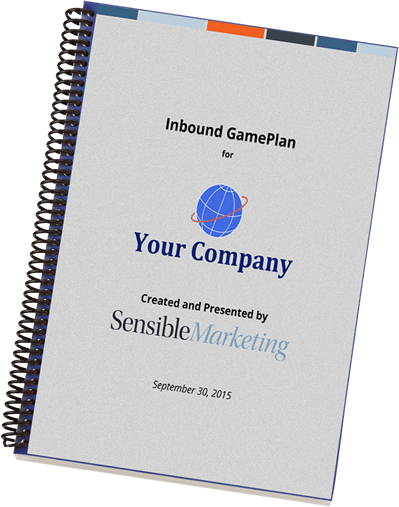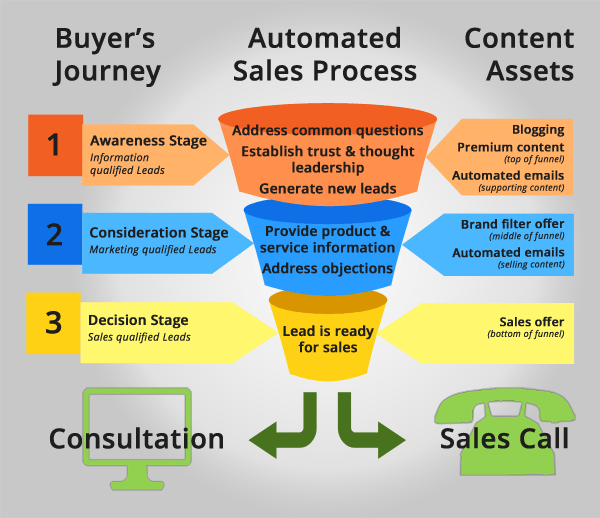 As marketers, we’ve all had the thought, “I wish someone would just TELL me what to do!” Blogging, social media, email marketing, website maintenance, event marketing, direct mail, paid ads, videos, posters, and promotions. How can anyone sort through the seemingly endless possibilities and constant barrage of “Increase website traffic by 10,000% in 30 days!” schemes?
As marketers, we’ve all had the thought, “I wish someone would just TELL me what to do!” Blogging, social media, email marketing, website maintenance, event marketing, direct mail, paid ads, videos, posters, and promotions. How can anyone sort through the seemingly endless possibilities and constant barrage of “Increase website traffic by 10,000% in 30 days!” schemes?
Maybe those schemes work for the Neil Patels and the Seth Godins of the world, but not for us normal marketing Joes. We just don’t have the time and we don’t know where to start.
That’s why we created the Sensiblez Marketing GamePlan™. The GamePlan is a 50+ page detailed, actionable strategy that includes the foundation for all future marketing and lays out the next six months of marketing efforts.
How it works
You know as well as we do that marketing and sales today revolve around the customer, not the other way around. Therefore, our marketing strategy must be all about the customer.
Start with the buyer’s journey
The buyer’s journey tells us how a prospect realizes he/she has a pain, researches to learn more about the pain, and finds a solution. On the left side of the image, we see how this works from the buyer’s perspective.

They begin at the Awareness Stage (meaning they have an awareness of a pain and are starting their research). As they consume content and learn more, they start to find potential solutions (your company and your competitors) to the problem, leading them to the Consideration Stage. They reach the Decision Stage when they have narrowed down their solutions to a few options, and are ready to talk to a salesperson to take the last steps before buying.
The funnel in the middle of the image above tells us marketers (and salespeople) what we need to provide to the potential customer at each stage for them to keep our company as a possible solution. The right side explains what we need to create in order to provide them the answers they are looking for at each stage.
Set the foundation
The above buyer’s journey is a great theoretical concept that every marketer should understand, but is completely useless to you. Wait, what? But you just said that’s where we need to start! And that’s correct! The image tells us where we (and the prospect) start, where we go, and where we end. However, there’s some research that we must do before we begin our marketing campaigns.
To set up your marketing to assist your buyers, you must know who your buyers are and what their pain points are.
This requires research. Lots of research. We must create one or more buyer personas (an illustration of your ‘ideal’ customer) and a list of keywords that describe their pain (and what they’ll be searching for online). Having buyer personas and keywords will help us design inbound marketing campaigns that speak to your prospects’ pain and help solve their problem.
The inbound marketing campaign
Now we get to the meat of the strategic marketing GamePlan – the action steps. The Inbound Marketing Campaign is a set of 90-day tactical strategies that will:
- attract your ideal customers to your website
- provide them with educational information and help
- give them an irresistible piece of content that gets to the root of their pain in exchange for their email address
- lead them through the buyer’s journey by continuously providing helpful, relevant content and answering their questions at every step of the way.
Awareness Stage
How is this done? It all revolves around an Awareness Stage premium content offer, such as an ebook, checklist, or whitepaper. This offer begins to provide a solution to the pain. But the prospects need to find this offer before they can download it. This happens through targeted (read: educational and informational – not company- or sales-oriented) blog posts and associated social media (and sometimes paid advertising). These all lead the prospect to the landing page to download the offer.
From there, a series of automated lead nurturing emails help answer questions that may come up as the prospect consumes the offer. These questions dig deeper to the root of the pain and begin to show possible solutions.
The lead nurturing emails lead the prospect to download a second piece of premium content, leading them to the consideration stage.
Consideration Stage
This premium content is different from the Awareness Stage content. It is more company-focused and solution-focused. Examples of Consideration Stage premium content include case studies, FAQs, comparison guides, and webinars.
At this point, the prospect has done quite a bit of research and is narrowing down possible solutions by looking at the features and benefits of your company and others. At this stage, they have more questions, and another set of automated lead nurturing emails is sent to answer those questions. The action at the end of the email is to get a Decision Stage offer.
Decision Stage
Decision Stage offers can be downloadable, but more often they are a free trial, demo, consultation, or other offer that gets the prospect on the phone or sitting in front of one of your salespeople. At this point, the prospect has spent hours researching and learning about your company, and is 70-80% through the buyer’s journey and about ready to buy.
And then. . . the sales team gets the lead
So the lead gets passed over to sales. Since your sales team knows the value of an inbound lead, knows what buyer persona fits for this prospect, and has immediate access to all the details of this particular prospect’s buyer journey, they are well positioned to close the sale.





